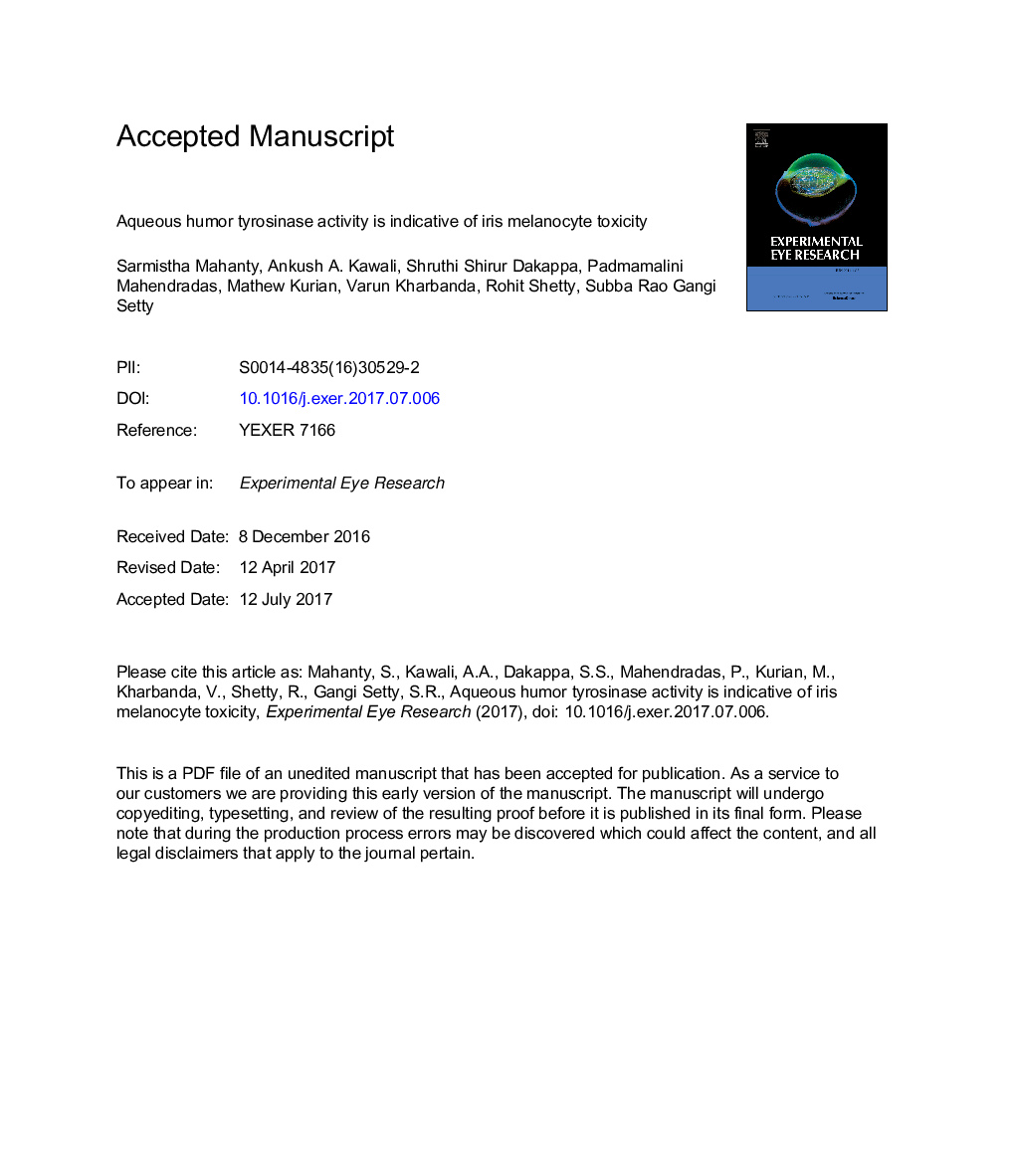| کد مقاله | کد نشریه | سال انتشار | مقاله انگلیسی | نسخه تمام متن |
|---|---|---|---|---|
| 5703963 | 1602560 | 2017 | 23 صفحه PDF | دانلود رایگان |
عنوان انگلیسی مقاله ISI
Aqueous humor tyrosinase activity is indicative of iris melanocyte toxicity
ترجمه فارسی عنوان
فعالیت طوفان آبی تریروزیناز نشان دهنده مسمومیت ملانوسیت عنبیه است
دانلود مقاله + سفارش ترجمه
دانلود مقاله ISI انگلیسی
رایگان برای ایرانیان
کلمات کلیدی
l-3,4-dihydroxyphenylalanine - L-3،4-دی هیدروکسی فنیل آلانینl-DOPA - L-DOPABenzalkonium chloride - بنزالکنیم کلریدTobramycin - ترومایسینTyr - تیرTyrosinase - تیروزیناز Mushroom tyrosinase - تیروزیناز قارچCiprofloxacin - سیپروفلوکساسینBait - طعمهFluoroquinolone - فلوروکینولونmelanin - ملانینMoxifloxacin - مکسیفلوکساسینBAK - پشت
موضوعات مرتبط
علوم زیستی و بیوفناوری
ایمنی شناسی و میکروب شناسی
ایمونولوژی و میکروب شناسی (عمومی)
چکیده انگلیسی
Antibiotics such as fluoroquinolones (FQLs) are commonly used to treat ocular infections but are also known to cause dermal melanocyte toxicity. The release of dispersed pigments from the iris into the aqueous humor has been considered a possible ocular side effect of the systemic administration of FQLs such as Moxifloxacin, and this condition is known as bilateral acute iris transillumination (BAIT). Bilateral acute depigmentation of iris (BADI) is a similar condition, with iris pigment released into the aqueous, but it has not been reported as a side effect of FQL. Iris pigments are synthesized by the melanogenic enzyme tyrosinase (TYR) and can be detected but not quantified by using slit-lamp biomicroscopy. The correlation between dispersed pigments in the aqueous and the extent of melanocyte toxicity due to topical antibiotics in vivo is not well studied. Here, we aimed to study the effect of topical FQLs on iris tissue, the pigment release in the aqueous humor and the development of clinically evident iris atrophic changes. We evaluated this process by measuring the activity of TYR in the aqueous humor of 82 healthy eyes undergoing cataract surgery following topical application of FQLs such as Moxifloxacin (27 eyes, preservative-free) or Ciprofloxacin (29 eyes, with preservative) or the application of non-FQL Tobramycin (26 eyes, with preservative) as a control. In addition, the patients were questioned and examined for ocular side effects in pre- and post-operative periods. Our data showed a significantly higher mean TYR activity in the aqueous humor of Ciprofloxacin-treated eyes compared to Moxifloxacin- (preservative free, p < 0.0001) or Tobramycin-treated eyes (p < 0.0001), which indicated that few quinolones under certain conditions are toxic to the iris melanocytes. However, the reduced TYR activity in the aqueous of Moxifloxacin-treated eyes was possibly due to the presence of a higher drug concentration, which inhibits TYR activity. Consistently, immunoblotting analysis of the aqueous humor from both Ciprofloxacin- and Moxifloxacin-treated eyes showed the presence of soluble TYR enzyme, thus reflecting its toxicity to iris melanocytes and corresponding to its activity in the aqueous humor. Intriguingly, none of these patients developed any clinically appreciable ocular side effects characteristic of BAIT or BADI. Overall, our results suggest that topical antibiotics cause different levels of iris melanocyte toxicity, releasing dispersed pigments into the aqueous humor, which can be measured through TYR enzyme activity. Hence, we conclude that topical FQLs may cause subclinical toxicity to the iris melanocytes but may not be the sole cause of the development of BAIT or BADI.
ناشر
Database: Elsevier - ScienceDirect (ساینس دایرکت)
Journal: Experimental Eye Research - Volume 162, September 2017, Pages 79-85
Journal: Experimental Eye Research - Volume 162, September 2017, Pages 79-85
نویسندگان
Sarmistha Mahanty, Ankush A. Kawali, Shruthi Shirur Dakappa, Padmamalini Mahendradas, Mathew Kurian, Varun Kharbanda, Rohit Shetty, Subba Rao Gangi Setty,
